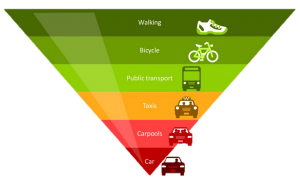Shared Mobility Should be a Part of Every SUMP
By Angelo Meuleman, Taxistop, BE
A Sustainable Urban Mobility Plan is a strategic plan designed to satisfy the mobility needs of people and businesses in cities and their surroundings for a better quality of life. It builds on existing planning practices and takes due consideration of integration, participation, and evaluation principles. [1] A SUMP is a very efficient tool to realize a serious impact on travel behaviour and one clear aim of the SHARE-North project is to promote the integration of shared mobility in every Sustainable Urban Mobility Plan (SUMP).
The European Commission is working closely with the member states to ensure that the SUMP concept is adopted by cities and regions, that SUMPs are adapted to the specific requirements and existing planning practices in each member state and actively promoted at national level in order to reach hundreds of cities in Europe.
A SUMP typically addresses the following topics[2]:
-
1. Public transport
-
2. Walking and cycling
-
3. Intermodality
-
4. Urban road safety
-
5. Road transport (flowing and stationary)
-
6. Urban logistics
7. Mobility management
-
8. Intelligent Transport Systems
It’s hard to find ambitions and strategies on shared mobility in SUMPs
Even though shared mobility (ride-sharing, bike-sharing, car-sharing) is often mentioned in guidelines and concrete SUMPs, it often lacks a real ambition and a clear strategic plan with responsibilities, investments, etc.
Shared mobility could have a significantly positive impact on travel behaviour, consumption of street space, accessibility and energy consumption. Shared mobility also simply enhances quality of life, therefore, it is very surprising that only a few cities like Bremen, Germany and Ghent, Belgium have action plans on shared mobility. If you recognise the benefits of shared mobility, it is really clear that shared mobility needs to be a part of every ambitious SUMP.
We detected 3 obstacles for the presence of shared mobility action plans in most SUMPS:
1. The transportation pyramid
According to the transportation pyramid, cities should prioritise cycling and walking first, as they are the healthiest, most space and energy efficient modes of transport. As next priority comes public transport. Between public transport and individual car use, we find collective car use like taxi, car-sharing and ride-sharing.
InfoDiagram.com
We are also convinced about this prioritising, but according to us it is very often misapplied. In terms of promoting sustainable mobility, you often have to scroll down a whole menu to find something about shared mobility.
Why don’t we use the transportation pyramid the other way around: If people are addicted to their car, we might convince them to share their car once in a while. Shared mobility could work as methadone to climb up the pyramid. It’s a matter of smart communication: Not a one-fits-all story, but tailor-made communication for each target group. On this, we could learn a lot from Google and Facebook.
2. Intermodal journeys vs. multimodal travel behaviour
Many travel planners still perceive shared mobility as a first or last-mile solution. There’s a strong political awareness about intermodality, but even though car-sharing or ride-sharing could work as part of an intermodal journey, it’s mostly used as unique mode for one trip.
The strength of shared modes is mainly on multimodal travel behaviour: different modes per user for different journeys. Members of car-sharing schemes, for instance, very often use public transport or cycling for commuting but sometimes use a shared car to visit their family on the weekend. Their access to shared cars makes their need for car-ownership obsolete.
The common misunderstanding that car-sharing is mainly a first or last-mile solution often contributes to an image of a complex mobility solution because intermodality is not always possible or not that easy.
3. It’s up to the market!
Shared mobility suppliers are very often independent companies. It is difficult to interact in this market, especially when competition is high. Therefore, it is necessary to have a good understanding of this market.
Shared mobility is a very broad spectrum of solutions for collective car-use. Even if solutions look really similar, business models and impact can vary a lot. For instance, corporate carpooling/liftsharing (focus on commuters) is much different than long distance carpooling schemes. Also, station-based and one-way car-sharing look similar but answer very different travel needs.
It’s up to municipal and regional governments to define their main objectives (for instance, modal shift, space consumption, accessibility) and to see if the market is supportive of this. If not, or not enough, the policy makers should interact. To learn more about the broad spectrum and impacts of shared mobility, read the Care-North+ factsheet on shared mobility or contact Taxistop or other SHARE-North partners.
During the SHARE-North project, we will create a toolbox for cities to maximize the benefits of shared mobility. Meanwhile, we create awareness by telling this story during conferences, seminars and political events. Check the events page on the SHARE-North website to find out where you can meet the project consortium and learn more about the benefits of shared mobility personally.
[1] Guidelines – European Platform on Sustainable Urban Mobility Plans http://www.eltis.org/sites/eltis/files/sump_guidelines_en.pdf
[2] ELTIS http://www.eltis.org/mobility-plans/sump-concept#sthash.gy5RUDn3.dpuf

 Share North
Share North

